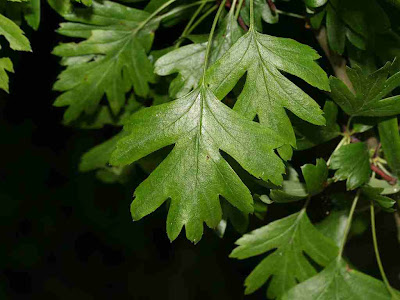 |
| Crataegus monogyna – Hawthorn – May Tree |
Hawthorn scientific name is Crataegus monogyna is a small tree, usually bushy shrubs with a spreading or
rounded crown of spiny intertwining branches and twigs, is a traditional component
of hedgerows and thus forms so much a part of the European landscape. It is
often called white thorn or ‘quick’ – the old word for living, because it
contrasted with the dead material used in earlier hedges and fences.
The zigzag shoots, except for some vigorous first-year ones,
are armed with numerous short spines. Along the shoots, which are dull red
above and green below, are set alternately very small reddish-black winter buds
with many scales. The small dull green leaves are variable in size and shape
with three to seven lobes usually cut more than half way towards the midrib.
The margins of the lobes are either undivided or bear a few teeth towards their
apex. The stipules, large on vigorous shoots, soon fall.
 Each inflorescence comprises up to about fifteen heavily
scented bi-sexual flowers, with petals which are usually white but occasionally
pink. The tree begins to bloom properly in May, hence its common alternative
name is ‘May’. The small round fruit ( the ‘haw’) changes in early September
from green to scarlet. It retains the withered style from the flower, and there
is very rarely more than one nutlet within the fleshy edible coat.
Each inflorescence comprises up to about fifteen heavily
scented bi-sexual flowers, with petals which are usually white but occasionally
pink. The tree begins to bloom properly in May, hence its common alternative
name is ‘May’. The small round fruit ( the ‘haw’) changes in early September
from green to scarlet. It retains the withered style from the flower, and there
is very rarely more than one nutlet within the fleshy edible coat.

 Each inflorescence comprises up to about fifteen heavily
scented bi-sexual flowers, with petals which are usually white but occasionally
pink. The tree begins to bloom properly in May, hence its common alternative
name is ‘May’. The small round fruit ( the ‘haw’) changes in early September
from green to scarlet. It retains the withered style from the flower, and there
is very rarely more than one nutlet within the fleshy edible coat.
Each inflorescence comprises up to about fifteen heavily
scented bi-sexual flowers, with petals which are usually white but occasionally
pink. The tree begins to bloom properly in May, hence its common alternative
name is ‘May’. The small round fruit ( the ‘haw’) changes in early September
from green to scarlet. It retains the withered style from the flower, and there
is very rarely more than one nutlet within the fleshy edible coat. 











No comments:
Post a Comment